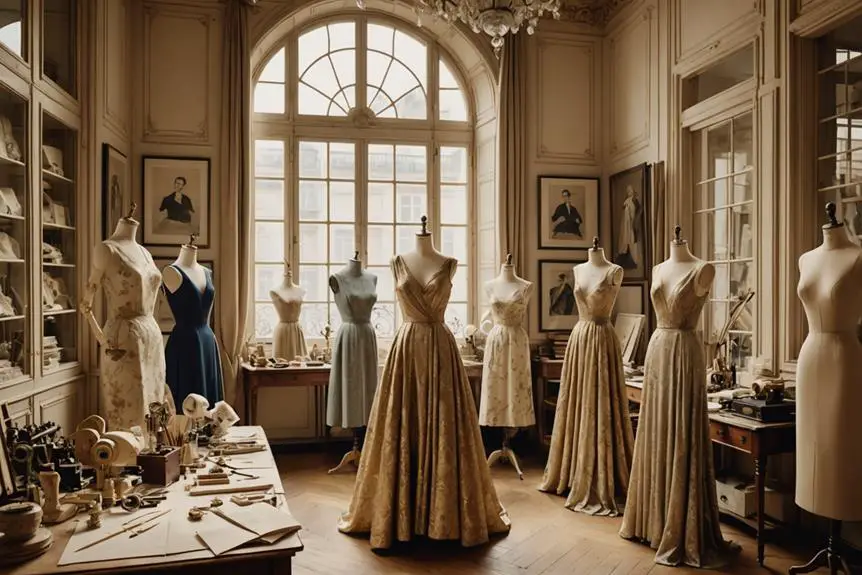The House of Balenciaga was founded in 1919 by Cristóbal Balenciaga, who grew up in Spain's Getaria. His early love for fashion, influenced by his seamstress mother, led him to open his first boutique in San Sebastián. Balenciaga later moved to Paris, where he redefined haute couture with innovative designs like the "sack" dress and "Cocoon" coat. His unique approach combined traditional craftsmanship with avant-garde styles, elevating women's fashion. Even today, Balenciaga's legacy influences modern designers and pop culture, illustrating the enduring impact of his visionary work in the fashion world. Explore more about his revolutionary designs and lasting effects.
Cristóbal Balenciaga's Early Life

Growing up in Getaria, Spain, Cristóbal Balenciaga developed a passion for fashion early on, thanks to his upbringing in a family steeped in craftsmanship—his father was a fisherman and his mother a seamstress.
From a young age, you can see how these influences shaped his creativity and skills. Balenciaga's journey mirrors that of many influential designers, such as Vivienne Westwood's legacy, who also revolutionized fashion through unique craftsmanship.
At just twelve years old, Balenciaga began a tailoring apprenticeship, which laid the groundwork for what would become a remarkable career in fashion design. His dedication paid off when he became the protégé of the Marchioness de Casa Torres, granting him the opportunity to study in Madrid and refine his talents.
By 1918, Balenciaga opened his first boutique in San Sebastián, Spain, quickly capturing attention with innovative designs that pushed the boundaries of fashion. His work was groundbreaking, and it wasn't long before he went from a small-town boy to a key player in the fashion world.
This early success set the stage for the founding members of what would later evolve into the renowned Balenciaga fashion house.
In 1937, Cristóbal Balenciaga moved to Paris, where his reputation as a couture house designer soared. He became celebrated for modern silhouettes and inventive tailoring techniques.
Balenciaga wasn't just creating clothes; he was redefining fashion itself. His journey from Getaria to the heart of fashion in Paris showcases the transformative power of talent, hard work, and a deep-rooted passion for craftsmanship that began in his childhood.
Establishment of the House
Established in 1919 by Cristóbal Balenciaga, the House of Balenciaga began its journey in San Sebastián, Spain, where the designer's innovative vision quickly captured the attention of fashion enthusiasts. Balenciaga opened a boutique that showcased his unique approach to design, blending traditional craftsmanship with fresh ideas. His early creations laid the groundwork for what would become a revolutionary influence in haute couture.
In 1937, Balenciaga made a significant move to Paris, opening his couture house at 10 Avenue George V. This shift marked the brand's entry into the heart of the fashion world, where his innovative designs began to flourish. The House of Balenciaga quickly gained acclaim, redefining women's fashion with groundbreaking tailoring techniques and silhouettes.
One of Balenciaga's most notable contributions was the "sack" dress, challenging conventional forms and offering a new perspective on femininity. The "baby doll" dress further solidified the house's reputation as a reference point in haute couture, showcasing how Balenciaga could blend elegance with a sense of playfulness.
Over the years, the House of Balenciaga has experienced various leadership changes, yet it has remained committed to Cristóbal's legacy. Designers like Nicolas Ghesquièr and Demna Gvasalia revitalized the brand, ensuring that the innovative spirit of Balenciaga continues to resonate.
Today, the house stands as a proof of Balenciaga's genius, reflecting a rich history while shaping the future of fashion.
Key Innovations and Designs

Innovation defines the legacy of the House of Balenciaga, with Cristóbal Balenciaga at the helm, constantly pushing the boundaries of fashion. His revolutionary designs changed how you perceive and wear clothing.
In the 1950s, he introduced the "sack" dress, an innovative silhouette that eliminated the waistline, allowing women to embrace a new sense of freedom and comfort. This marked a significant shift in women's fashion, breaking away from traditional structures.
By 1960, Balenciaga revealed the "Cocoon" coat, showcasing his mastery of tailoring. Its voluminous shape and minimal structure highlighted his avant-garde approach, making it a must-have piece for the modern woman.
He didn't stop there; Balenciaga was also a pioneer in using unconventional materials. Gazar d'Abraham, a lightweight yet structured fabric, enabled him to create dramatic silhouettes that captivated fashion enthusiasts.
In 1958, the introduction of the "Baby Doll" dress altered perceptions of femininity. Balenciaga emphasized a playful, yet sophisticated aesthetic, making it clear that comfort could coexist with style.
His designs often featured architectural shapes and bold colors, influencing the modern silhouette and inspiring countless designers.
Through these key innovations, the House of Balenciaga set a high standard in fashion. You can see the lasting impact of Cristóbal Balenciaga's work today, as his innovative spirit continues to shape the industry, reminding everyone that fashion isn't just about clothing—it's about expression.
Influence on Fashion Industry
Cristóbal Balenciaga's influence on the fashion industry is nothing short of transformative, shaping the way designers approach silhouette and structure. His innovative designs, such as the tunic dress and the Empire line, became staples of modern silhouettes in the 1950s, redefining what fashion could be.
Here are four key aspects of his impact:
- Architectural Shapes: Balenciaga's pioneering use of bold colors and architectural shapes challenged traditional tailoring techniques, setting a new standard for haute couture.
- Inspiration for Others: His groundbreaking work influenced contemporaries and future designers like Paco Rabanne and Hubert de Givenchy, ensuring his vision extended beyond his own collections.
- A New Approach to Craftsmanship: By blending traditional craftsmanship with avant-garde concepts, Balenciaga paved the way for a fresh perspective on fashion, encouraging designers to think outside the box.
- Ongoing Legacy: Even today, Balenciaga's legacy continues to shape the fashion industry, with exhibitions and academic studies exploring his techniques and their lasting impact on modern design and trends.
Through these innovative designs, Balenciaga didn't just create garments; he redefined the parameters of fashion itself.
His work remains a reference point for contemporary designers, illustrating how one visionary can alter the course of an entire industry. Balenciaga's contributions to haute couture aren't just historical footnotes; they're living influences that inspire new generations of creators.
Legacy and Cultural Significance

How has the legacy of Balenciaga shaped the cultural landscape of fashion? The House of Balenciaga has left an indelible mark on modern design, with Cristóbal Balenciaga recognized as a true pioneer. His innovative creations, like the revolutionary "sack" dress and playful "baby doll" dresses, challenged traditional silhouettes and transformed haute couture and ready-to-wear fashion.
You can see how his legacy continues to influence countless designers today, as they draw inspiration from his avant-garde aesthetics and unique tailoring techniques.
Balenciaga's cultural impact goes beyond runways. His designs have crossed into pop culture, appearing in films, music videos, and collaborations with top celebrities and artists. This blend of high fashion and mainstream appeal broadens the brand's reach, making it relevant to a diverse audience.
Ongoing exhibitions, such as the Cristóbal Balenciaga Museum, celebrate his contributions, highlighting how his work resonates in both historical and modern contexts. These retrospectives reinforce the significance of his legacy, reminding us that Balenciaga isn't just a name; it's a symbol of innovation and artistic expression in fashion.
As you explore the world of fashion, you'll find that Balenciaga's influence is everywhere, shaping styles and inspiring new generations. His commitment to pushing boundaries guarantees that his legacy remains alive, continually inspiring designers and fashion lovers alike to embrace creativity and challenge norms.




